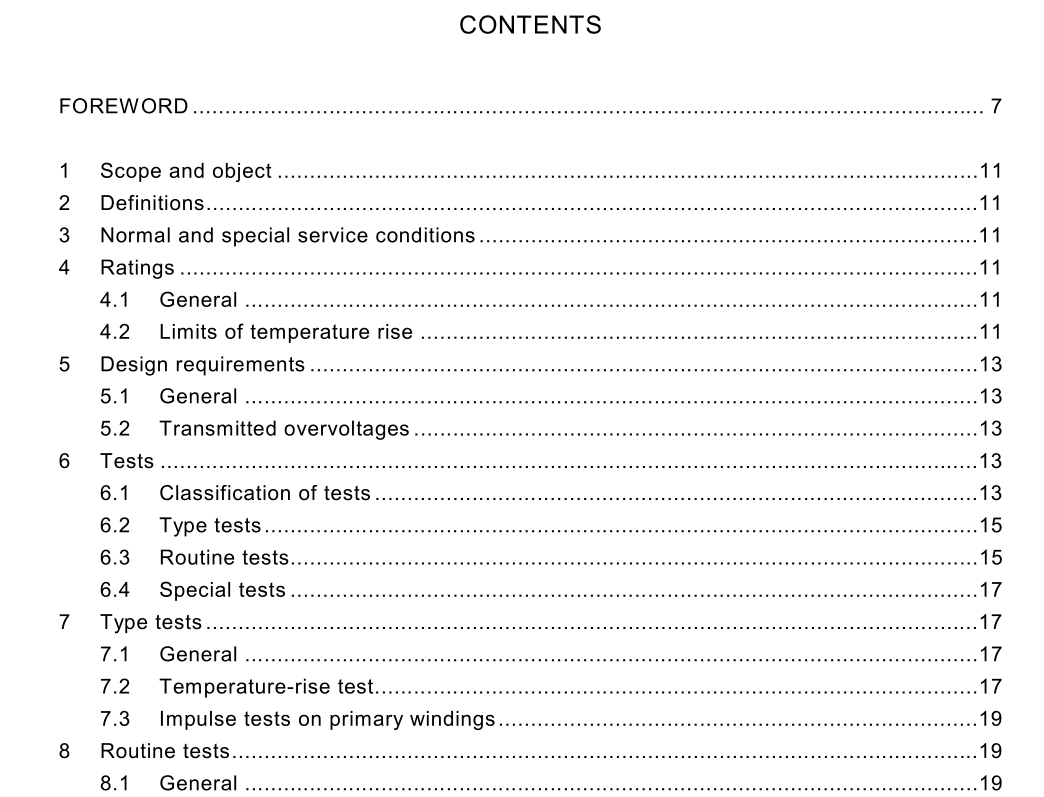IEC 60044-3 pdf download

IEC 60044-3 pdf download.Instrument transformers
1 Scope and object
This part of IEC 60044 applies to newly manufactured combined transformers for use with electrical measuring instruments and electrical protective devices at frequencies from 15 Hz to 100 Hz. The requirements and tests of this standard, in addition to the requirements and tests of IEC 60044-1, IEC 60044-2 and IEC/PAS 60044-5 cover current, voltage and capacitor voltage transformers, that are necessary for combined instrument transformers.
2 Definitions
For the purposes of this part of IEC 60044, the definitions given in IEC 60044-1 and IEC 60044-2 and the following definition apply. 2.1 combined instrument transformer instrument transformer consisting of a current and a voltage transformer in the same case
3 Normal and special service conditions
For the purposes of this part of IEC 60044, Clause 3 of IEC 60044-1 and Clause 4 of IEC 60044-2 apply to current and voltage transformers respectively.
4 Ratings
4.1 General For the purposes of this part of IEC 60044, in addition to Clause 4 of IEC 60044-1 and Clause 5 of IEC 60044-2, the following subclause applies. 4.2 Limits of temperature rise The temperature rise of a combined instrument transformer shall not exceed the appropriate values of 4.6 of IEC 60044-1 and of 5.4 of IEC 60044-2, respectively, if a voltage as indicated in IEC 60044-2, 5.4, is applied to it and the current transformer is carrying a primary current equal to the rated continuous thermal current. The current transformer is connected to a unity power factor burden corresponding to the rated output and with the voltage transformer being loaded at rated burden, or at the highest rated burden if there are several rated burdens, and at a power factor between 0,8 lagging and unity. The additional tolerance of 10 K proposed in some cases for the voltage transformers is also applicable for the current transformers of the combined instrument transformers.
6.2 Type tests
The following tests are type tests; for details, reference should be made to the relevant subclauses: a) short-time current test on current transformers (see 7.1 of IEC 60044-1); b) temperature-rise test (see 7.2); c) lighting impulse test (see 7.3 and also 7.3.2 of IEC 60044-1 for current transformers and 8.3.2 of IEC 60044-2 for voltage transformers); d) switching impulse test (see 7.3 and see also 7.3.3 of IEC 60044-1 for current transformers and 8.3.3 of IEC 60044-2 for voltage transformers); e) wet test for outdoor transformers (see 7.4 of IEC 60044-1 for current transformers and 8.4 of IEC 60044-2 for voltage transformers); f) short-circuit withstand capability test on voltage transformers (see 8.2 of IEC 60044-2); g) determination of errors (see Clause 11); h) measurement of the radio interference voltage (RIV) (see 8.5 of IEC 60044-2). All the dielectric type tests shall be carried out on the same transformer, unless otherwise specified. After the transformer has been subjected to the dielectric type test of this subclause, it shall be subjected to all the routine tests of 6.3.
7 Type tests
7.1 General For the purposes of this part of IEC 60044, Clause 7 of IEC 60044-1 and Clause 8 of IEC 60044-2 apply to the current and voltage transformer respectively, unless otherwise specified below. 7.2 Temperature-rise test A test shall be made in order to prove compliance with 4.2. For the purpose of this test, combined instrument transformers shall be considered to have attained a steady-state temperature when the rate of temperature rise does not exceed 1 K/h. The ambient temperature may be between 10 °C and 30 °C. When there is more than one secondary winding, the tests shall be made with the appropriate rated burden connected to each secondary winding unless otherwise agreed between manufacturer and user. For the test, the transformer shall be mounted in a manner representative of the mounting in service. The prescribed current and voltage are applied simultaneously to the combined instrument transformer. For this purpose, it is necessary that the primary winding and the secondary winding of the transformer generating the high current which excites the current transformers are insulated in relation to one another for the full voltage of the network. If such a transformer is not available, two other test arrangements are recommended. a) The combined instrument transformer may be installed insulated. The high voltage is then applied simultaneously to the frame, to the casing, to the terminal of the primary winding usually earthed in service, and to one terminal of each secondary winding, whilst the terminal of the primary winding applied to the mains line in service is earthed. Thus the insulation of the transformer generating the current need not be constructed for high voltage. b) The high voltage is applied to the terminal which is connected to the main line in service. Primary terminals of the current transformer are short-circuited and connected to the high voltage.









